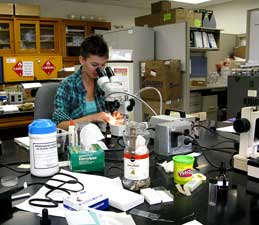Lichen Project: What We Do
Most subtropical/tropical lichens must be analyzed in the laboratory before a definitive identification can be determined.
The first step is close observation under an inspection microscope. Sometimes this provides enough information to work through the appropriate dichotomous key and arrive at an identification. More often, however, the key asks for information requiring sectioning of the lichen's fruiting body (apothecia).

Klara sectioning lichen.
Apothecia sectioning requires making thin slices with a razor blade under an inspection microscope and placing the resulting sections on a microscope slide. These are held in place with a cover slip for viewing under a compound microscope.
Under the compound microscope, if sections are good, internal structures (thin section, ascus, spores, etc.) can be observed and measured. Spores are most important, followed by other structures of varying significance depending on the genus.
Chemical composition is another identification tool. Sometimes a simple spot test is sufficient; however, often more extensive analysis is needed requiring the use of Thin Layer Chromatography (TLC). Here a lichen concentrate is "spotted" on treated glass plates and processed in various chemical solutions depending upon suspected chemicals.
Information is recorded on a data processing worksheet throughout the process. This worksheet (together with attached lichen) becomes the focus of much additional work. First, professional literature is searched to determine if the lichen has been described/named. This is often a daunting task because literature may be scattered in obscure, not accessible journals. After extensive work, if no name can be found the lichen will be described as new to science.
Once investigation complete as possible, data is recorded in an Excel spreadsheet to assure retention of and access to all information. (An additional spreadsheet is necessary for lichens being submitted to the South Florida Collections Management Center.) A label is prepared, printed and attached to the properly prepared lichen for storage.